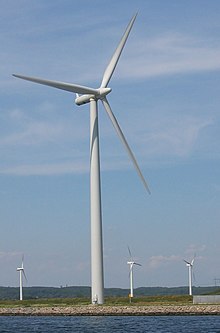Everybody wants to be green but nobody wants tell you what that means exactly.
http://en.wikipedia.org/wiki/Carbon_offset
Carbon offset
From Wikipedia, the free encyclopedia

Wind turbines near Aalborg, Denmark. Renewable energy projects are the most common source of carbon offsets.
A carbon offset is a financial instrument aimed at a reduction in greenhouse gas emissions. Carbon offsets are measured in metric tons of carbon dioxide-equivalent (CO2e) and may represent six primary categories of greenhouse gases.[1] One carbon offset represents the reduction of one metric ton of carbon dioxide or its equivalent in other greenhouse gases.
There are two markets for carbon offsets. In the larger, compliance market, companies, governments, or other entities buy carbon offsets in order to comply with caps on the total amount of carbon dioxide they are allowed to emit. In 2006, about $5.5 billion of carbon offsets were purchased in the compliance market, representing about 1.6 billion metric tons of CO2e reductions.[2]
In the much smaller, voluntary market, individuals, companies, or governments purchase carbon offsets to mitigate their own greenhouse gas emissions from transportation, electricity use, and other sources. For example, an individual might purchase carbon offsets to compensate for the greenhouse gas emissions caused by personal air travel. Many companies (see list[3]) offer carbon offsets as an up-sell during the sales process so that customers can mitigate the emissions related with their product or service purchase (such as offsetting emissions related to a vacation flight, car rental, hotel stay, consumer good, etc.). In 2008, about $705 million of carbon offsets were purchased in the voluntary market, representing about 123.4 million metric tons of CO2e reductions.[4]
Offsets are typically achieved through financial support of projects that reduce the emission of greenhouse gases in the short- or long-term. The most common project type is renewable energy, such as wind farms, biomass energy, or hydroelectric dams. Others include energy efficiency projects, the destruction of industrial pollutants or agricultural byproducts, destruction of landfill methane, and forestry projects.[5] Some of the most popular carbon offset projects from a corporate perspective are energy efficiency and wind turbine projects.[6]
:}
http://ezinearticles.com/?Carbon-Neutral—What-Does-It-Mean?&id=339090
Carbon Neutral – What Does It Mean?
Recently, there have been a lot of environmental buzzwords floating around. It can be difficult to find a clear definition. I’ll explain what the term “carbon neutral” means, and why it’s important.
You might think that carbon neutral simply means that something does not release any carbon dioxide into the atmosphere. This is true to an extent, however it is too simple a definition. It is possible to release CO2 into the atmosphere and still be carbon neutral, so long it is balanced by a CO2 reduction elsewhere.
Biofuels are carbon neutral, even though burning them releases CO2. How can this be? Well, the carbon in the biofuel comes from photosynthesis, where CO2 is captured from the atmosphere by a plant and turned into glucose. The glucose can then be turned into more complicated molecules such as sugars, starches, oils and proteins. Sugars and starches can easily be converted into bioethanol, while oils can be converted into biodiesel. Carbon is removed from the atmosphere, stored in plants for a few months, then released when the biofuel is burned. For every gram of CO2 released by burning a biofuel, there was a gram removed from the atmosphere by photosynthesis just a few months ago. This perfect balance is why biofuels are carbon neutral.
Alternatively, the term carbon neutral can be used to describe energy that does not cause the release of any CO2 at all. For instance, solar cells, wind turbines and hydroelectric turbines generate electricity without releasing CO2. Nuclear power does not release CO2 during the generation process either.
There is a problem with this, however. Currently, virtually all forms of carbon neutral energy actually involve the burning of fossil fuels. The crops for biofuels are harvested using machinery that burns fossil diesel. This is because fossil fuels are a great deal cheaper than biofuels. Some ways of producing biofuels are controversial because so much fossil fuel has to be used in the production process. Some sources of bioethanol are in this grey area. Solar cells, wind and hydroelectric turbines are all produced and transported using fossil fuels to some extent. The technology exists to make these things truly carbon neutral, but it is hopelessly uneconomic at this time. Nuclear power involves the burning of fossil fuels in the mining and transport of uranium, the building of power stations, and the disposal of waste. When uranium becomes scarce, mining it will consume even more fossil fuels:}
:}
http://www.leonardo-energy.org/meaning-zero
‘Zero energy building’ and similar terms

Picture by Ian Britton on FreeFoto.com
You would think that no word has a more unambiguous meaning than ‘zero’: nothing is nothing. Not so in today’s world of green building. Labels like ‘zero energy building’, ‘nearly zero energy building’, and ‘zero carbon building’ are frequently used, but lack any standardised or official definition. The same can be said of the expression ‘bâtiment à énergie positive’ that is used in France.
‘Zero energy’ might play well commercially, but it is a clumsy label from a scientific point of view. No house or building can be built and maintained without energy. Strictly speaking, even manpower should be considered energy, and it brings along carbon emissions via food production and by the simple act of breathing. This illustrates that the meaning of ‘zero’ depends entirely upon where you draw the system’s boundaries.
The most narrow and also the most deceptive definition is to take only the electricity consumption of the building into account. The annual electricity production of the PV cells on the roof equals the annual electricity consumption of the building, and hey presto, you have a zero energy building. Who cares about the natural gas boiler in the basement?
Nearly zero energy
:}
Nearly zero..ha..haha…more tomorrow.
:}


 Logged
Logged


















